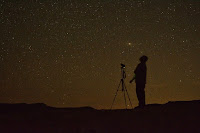Introduction
August was a great month as far as weather and astronomy are concerned. The Perseids did not disappoint observers and viewing Saturn around its opposition was a treat. Jupiter was also a delight to view as it nears its own opposition. We also experienced two Full Moons during August, which aren't necessarily great for stargazing, but still an extraordinary event for the month.
September typically brings cooler temperatures to Utah as well as an increase in stormy weather. Astronomically speaking, September will bring the opposition of Neptune and great views of Saturn, which just reached opposition, and Jupiter, which will reach opposition in early October. Mercury and Venus will inhabit the morning sky with Jupiter being easy to spot in the southwest shortly before sunrise. September also brings the autumnal equinox. The most exciting event will come during the first half of the month when a naked-eye comet will be visible in the early morning sky. Read on for more information!
Potential Naked-Eye Comet
A recently discovered comet has the potential to become a naked-eye comet. Nishimura, a comet discovered by an amateur Japanese astronomer on 12 August has grabbed the attention of many astronomers. As of this writing, Nishimura is glowing at a dim 8.5 magnitude, which requires a pair of binoculars or a telescope to view. However, this comet is quickly brightening and is expected to reach a magnitude close to 3.4 which puts this in the range that a human eye can detect. Comets are extremely unpredictable due to their composition. Nishimura will be closest to the Earth on the 12th and 13th of September and its closest approach to the Sun on the 17th. The comet will be best viewed a couple of hours before sunrise during the first half of the month. Following the 17th, Nishimura can be seen in the evening sky shortly after sunset. The best chances of viewing this comet will be from a high elevation that provides a clear view of the eastern horizon for the first half of the month, and a clear view of the western horizon during the second half of September. A long exposure of the sky should reveal this comet's blueish-green nucleus and its tail.
To catch a glimpse of comet Nishimura, look towards the east shortly before sunrise until September 15th. After the 15th of September, gaze towards the west right after sunset. Find a dark sky location with a high elevation and an unobstructed horizon. Using a long-exposure image can capture the comet's color and tail in greater detail.
Monthly Breakdown
September 01: Moon passes within 2° of Neptune
September 04: Moon passes within 3° of Jupiter
September 05: Moon passes within 3° of Uranus
September 06: Mercury reaches inferior conjunction
September 06: Last Quarter Moon🌗
September 11: Moon passes within 11° of Venus
September 14: New Moon 🌑
September 16: Moon passes within 1° of MarsSeptember 19: Neptune reaches oppositionSeptember 19: Venus shines at its greatest brilliance
September 22: Mercury reaches greatest western elongation
September 22: First Quarter Moon 🌓
September 23: Autumnal equinoxSeptember 26: Moon passes within 3° of SaturnSeptember 28: Moon passes within 2° of NeptuneSeptember 29: Full Moon 🌕










